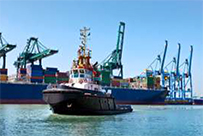DEC study: Export-orientation policy drives economic transformation
Export-orientation has been credited as a successful development strategy leading to economic transformation while sustained export-oriented policies have been associated with significant export diversification, according to a working paper on productivity of exporting firms in Dubai in two economic zones, Dubai main and free zones.
The paper also described how countries, which initially remained confined to exploiting the natural resources they were endowed with, sought to avoid abrupt sector-specific shocks by shifting towards manufacturing. The export of manufactured products was seen as non-traditional export.
In fact, non-traditional exports are characterized by higher income elasticity, less volatile terms of trade, and higher prospects of dynamic productivity gains, said the paper prepared by the Economic Policy & Research Center (EPRC), the operational arm of Dubai Economic Council (DEC).
Dubai has recently launched a far-reaching development plan (the Dubai 2021 Development Plan). Among other things, this plan is aimed at enhancing high productivity through the promotion of the ‘light manufacturing sector’. The received wisdom about the role of manufacturing, especially manufacturing exports, in economic development should augur well for this strategic objective of the Dubai development plan.
A more prominent role for manufacturing, therefore, should entail higher productivity growth and, hence, more stable and sustainable growth. This has rightly been the main policy concern for Dubai in view of the increasingly volatile global economy, which has substantially impacted the highly open and largely service-oriented economy of the Emirate. Moreover, though the massive factor accumulation and superb business environment have been enough to allow Dubai to achieve one of the most phenomenal economic transformations in recent history, there is a wide consensus that this growth model might have now reached the point of diminishing returns.
Based on phone interviews with managers or senior staff in 982 firms, the Dubai enterprise level survey was designed to cover a representative sample based on eight industrial sectors (i.e. construction, financial services, hotels and restaurants, non-financial and social services, retail trade, wholesale trade, transport, storage and communication and manufacturing), and two zones (i.e., Dubai main and Dubai free zones).
Firms in FZs had a higher share of foreign investment compared to their DM counterparts with about 26 percent in the FZs and 4.4 percent in DM. However, non- exporting firms in FZs are attracting more foreign investments relative to their exporting counterparts in FZs (27.6 percent and 14.6 percent, respectively).
Firms in FZ are more capital intensive than their DM counterparts (AED50,000 of capital per worker in FZ against AED30,000 in the case of DM). Moreover, non-exporting firms in FZ have more capital intensity than exporting FZ firms, with AED56,500 per worker in the former and AED37,500 per worker in the latter).
According to the policy recommendations, the focus of the ‘light industry’ initiative of the Dubai 2021 Plan should target enhancing productivity, since these manufacturing firms are likely to be less productive than other firms. In view of the dominance of SMEs in the manufacturing sector, the agenda for promoting ‘light manufacturing’ should also be driven by those related to the promotion of SMEs, such as better access to finance and registry of assets.


